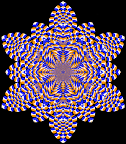The below item is composed of two solid pieces of wood. There are no holes in this block. If you grab the top piece and lift the bottom comes with it. I first saw this as the Visual Illusion of the month on Amos Storkey's site.
The top picture was pointed out to me by Rob of "What is it?" Rob's site has an array of pictures with the object being to guess what the object is in the picture.
All Rob has to say about this object is that it is the
Double dovetail puzzle
Amos presented the bottom picture with the following statement:
A craftsman took two solid pieces of wood, and carved them so they could be put together in the form illustrated below (the slight overhang is only used to illustrate the two parts). Each part is solid, and cannot be separated. The whole block is solid and has no spaces inside. The full cube could be lifted by picking up the top half.I have pondered this puzzle since I saw it on Amos' site. It wasn't until today when Rob of What is it? dropped me an e-mail did I decide to put some serious thought to this puzzle.
How was this cube created (no adhesive used)?
It took me a couple of minutes of thought then the answer hit me. I love this kind of puzzle. It works because we always make assumptions, it isn't until you throw those assumptions away that the answer reaches out and smacks you in the face.
Once the solution came to me I decided to include the photo from Amos' site . The bottom photo is a blatant clue on how this puzzle is done. You might as well show the construction blueprint.
Let's see who is the first person to comment correctly on this puzzle.
Good luck!









9 comments:
Nice one.
The "joints" that keep together the two parts are actualy paralel to each other, (they are not going from a side to it's oposite and crossing each-other in the middle, but rather from the middle of one side to the the middle of the oter perpendicular to it)
If the first comment wasn't clear enough check this .
The dovetail top piece just slides off at a diagonal.
The two blocks were attached permanently together and the dovetails were carved in. The two blocks are stained different colors
It started as a solid block and the dovetails were carved in later.
You slide the two pieces together to form the cube.
I saw the WoodWright on PBS make one of these once.
The dovetails are not at a 90 degree angle to the side of the cube, but rather a 45 degree angle providing two "rails" on which to slide the upper half onto the lower half.
Below are comments that were archived on Haloscan.com
===========================
The assumption that one would probably make is that the wedges sides continue as is into the centre of the block and to the other side of the block (cross formation). Which it obviously doesn't. If you design the wedges track its edges from one wedge to the other wedge around the next corner, thus allowing to shift in the the blocks upon each other. thus the two wedges would run parallel to each other.
Andre | 04.22.05 - 3:53 am | #
==================================================
Yeah, what the above said. I included a link to my blueprint (a messy version, anyway).
Assumptions be damned!
Daria | Homepage | 04.22.05 - 7:36 am | #
==================================================
Daria's comment and blueprint is perfectly right.
This one seemed obvious to me, though I have to admit that I am used to create wooden objects...
This one is definitely the next object I'll create! (will even be a box)
Jean-Marc | 04.22.05 - 9:53 am | #
==================================================
Andre, Excellent work.
Here is Daria's blueprint.
http://img.photobucket.com/album...ts/ dovetail.jpg
Thanks All,
Walt
Walt | Homepage | 04.22.05 - 11:25 am | #
==================================================
Thanks Walt, I have my moments...
Andre | 04.25.05 - 7:13 am | #
==================================================
it slids on the diagonal, isn't it?
EKIza | Homepage | 04.29.05 - 6:32 am | #
EKIza,
Si
Walt
Walt | Homepage | 04.29.05 - 11:09 pm | #
==================================================
Ha. I came up with a completely different method of doing it when I saw the item at puzzlephotos and didn't give it any more thought.
In my mind, I saw the dovetail notch as an arc, a quarter of a circle, that would allow the pieces to separate by turning one.
Elijah | 05.24.05 - 4:16 pm | #
==================================================
If you were able to turn one piece then they wouldn't be two solid pieces with no gaps or holes inside. But if that wasn't stated on photo puzzles then you have a workable idea.
Walt | Homepage | 05.24.05 - 8:39 pm | #
==================================================
to me it looks like they probably just cut a square block around one end to make it look like it was actually carved in dovetails. also, for the top pic, some creative and careful painting was used. the fact that when you pick up the top the bottom comes with it and there's no obvious way to separate the 2 only serves to make you think "inside the box" when its always better to think "out of the box!!" i love this site-it really makes you think out of the box. it messes with your perceptions of life and reality-its so cool!! i don't know if i'm right about the box-i hope i am-if not someone pls let me know!
chanda | 10.12.05 - 4:01 pm | #
==================================================
Chanda,
There were more posts here previously explaining this puzzle. Now the puzzle is for me to figure out what happened to them. (turns out that with Haloscan comments are archived after 4 months)
Check out this image.
http://www.uncg.edu/%7Ewhanthon/...ions/ square.JPG
The dovetail top piece just slides off at a diagonal.
Walt | Homepage | 10.13.05 - 5:43 pm | #
==================================================
There is a pin inside to lock it. It is not just to push them apart although you know part of the secret
http://woodstore.net/perfectpuzzler.html
Post a Comment | Random Illusion